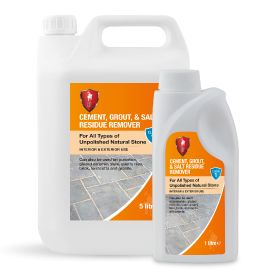
Have you noticed a white power-like residue on your pavers? If so, this stain is probably efflorescence. Often referred to as a ‘bloom’, efflorescence is common on brick walls but it can also rise through grout joints and leave unsightly stains on the surface of tiles and pavers. It can easily be removed but it’s important to use the correct product, to avoid damaging the tile surface.
What is efflorescence?
Efflorescence is made up of soluble salts and moisture which rise, evaporate and leave behind a crystalline salt deposit. It can occur after a spell of wet or cold weather, or build up gradually, and it’s often a seasonal problem. Standard cleaning products won’t effectively remove it.
Brick acid – a traditional acid cleaner – is often recommended by the building trade as a go-to solution but there are many reasons why this shouldn’t be used. Brick acid is hazardous and corrosive. It often has ahydrochloric base which can strip the top layer from a paver. It’s especially damaging to acid-sensitive materials, like limestone, where it effectively eats away at the surface.
Safe removal of efflorescence

For the safe, effective removal of efflorescence, we recommend LTP Cement, Grout & Salt Residue Remover. An acid-replacement treatment, the Remover has a synthetic base, so it is safe to use on all types of tile and natural stone surfaces, except those with a polished finish. This means that it can be safely applied to unpolished acid-sensitive surfaces, including limestone and travertine, as well as unpolished porcelain, glazed ceramic, slate, quarry tiles, brick, terracotta and granite and masonry. The treatment also removes rising salt caused by substrate moisture and spot fixing – as well as cement and grout residues – and, unlike harsh acidic treatments, it does not tarnish chrome or steel. It is safe to use indoors and outdoors.

- To remove mild staining and to treat non-absorbent surfaces, dilute 1 part of the Remover with 4 parts of cool water. Always dilute the treatment by adding it to water, rather than the other way around.
- Apply with a cloth or sponge wrung out in the solution. Leave to act for up to 30 minutes.
- Wipe away the released surface residue with a sponge and cool, clean water.
For more severe staining, use a 1:1 dilution and, if necessary, agitate the surface with a scrubbing brush. Leave to act for 5-10 minutes, keeping the surface wet with additional Remover. Wipe away the residue and rinse, as before.
In extreme cases, the Remover can also be applied neat and the surface agitated with a nylon pad, scrubbing brush or mechanical scrubber. Residues should then be removed straight away and the surface rinsed immediately.
All LTP treatments are made and stocked in the UK. To find out more, visit http://www.ltp-online.co.uk or contact LTP on tel. 01823 666213 or email [email protected].



